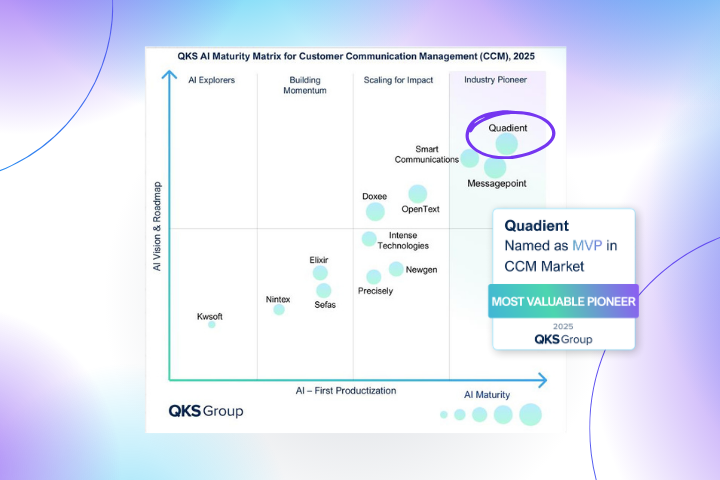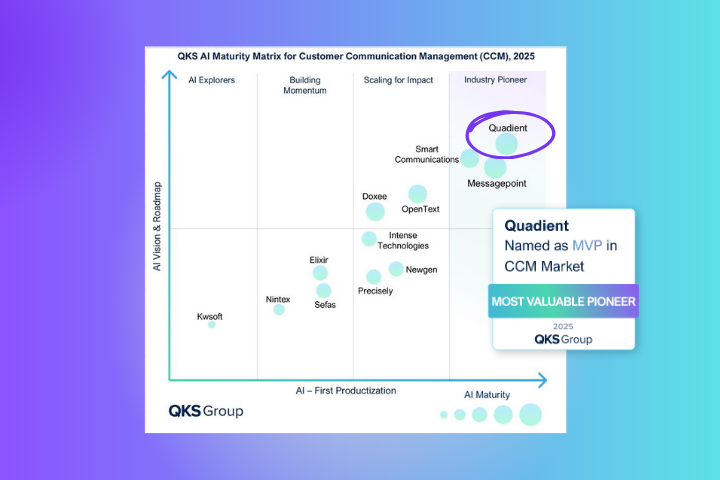Introduction
Exceptional customer experience (CX) drives loyalty and growth. To achieve this, businesses need content that is modular, data-aware, and easily reusable. When you pair intelligent content with customer experience management (CXM), you can eliminate silos, maintain consistent messaging, and tailor every interaction to meet individual needs. This article defines intelligent content, explains how customer communication management (CCM) transforms communications across channels, and outlines the steps and metrics required to make it effective.
Why intelligent content matters
Customers expect you to anticipate their needs across web, mobile, email, chat, and support. Inconsistent messages erode trust. Intelligent content provides a unified approach to planning, creating, approving, and delivering communications, ensuring a seamless experience.
At its core, intelligent content is structured, reusable, and enriched with metadata. With CCM as the control point, teams can automate workflows, ensure accuracy, and personalize at scale. Artificial intelligence (AI) and machine learning (ML) turn static assets into adaptive content that addresses pain points and improves engagement.
When every message aligns with the brand and policy, customers spend less time searching for answers, which improves customer satisfaction and loyalty.
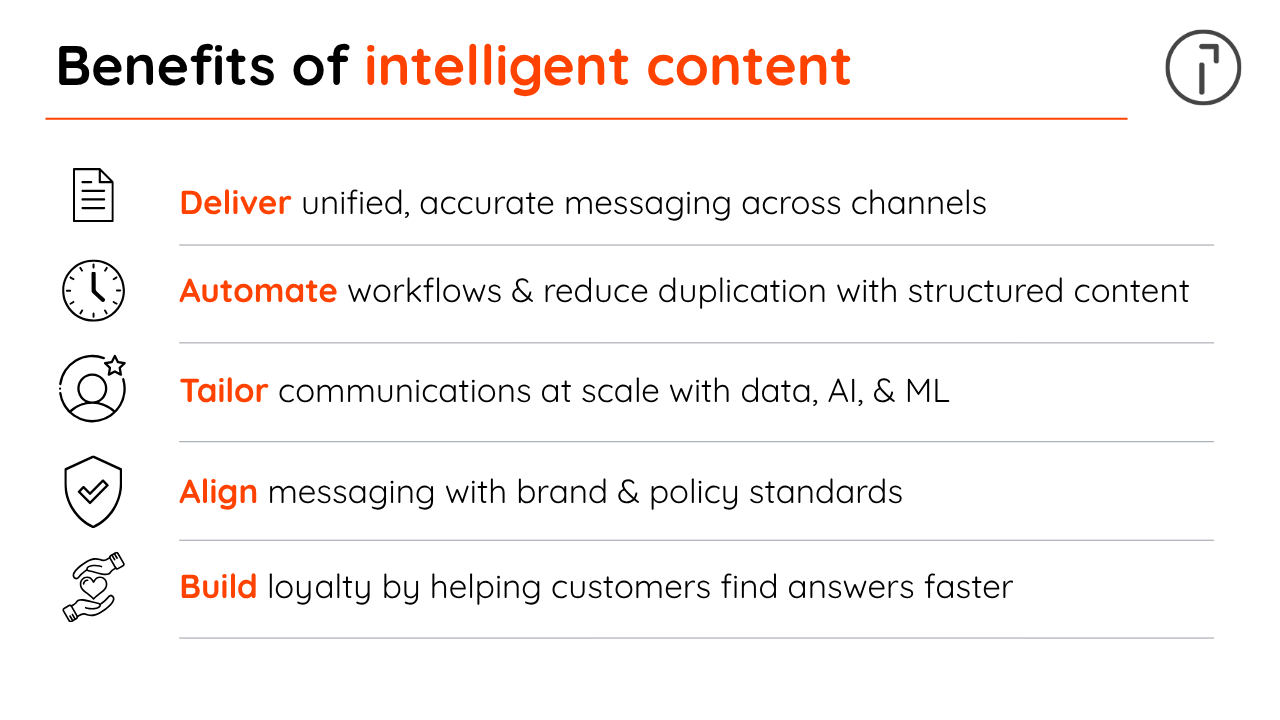
What makes content intelligent?
To scale content without losing control, design it to be modular, tagged, and data aware. The points below describe the traits that make content easy to find, reuse, and personalize across channels.
- Modular by design: Write in small building blocks such as headlines, body copy, legal text, and calls to action. Reuse them across products, regions, and channels. This is the foundation of modular content and content reuse.
- Metadata rich: Tag each block with attributes like audience, journey stage, product, risk class, language, and tone. Use semantic tags to power semantic search and content intelligence.
- Channel ready: Assemble once and render for web, app, email, print, or social media without rework. Support multichannel publication from a single source of truth.
- Data aware: Connect to CRM software, product data, and customer sentiment to personalize messages in real time.
- Governed: Apply version control, content guidelines, approvals, and audit trails so content stays compliant through the content lifecycle.
- Measurable: Track reuse rate, accuracy, and performance so you can improve with evidence.
- AI-enabled: Use AI-powered tools and machine learning to enrich tags, predict next best actions, summarize variants, and route approvals. Generative AI can draft options that authors and reviewers refine.
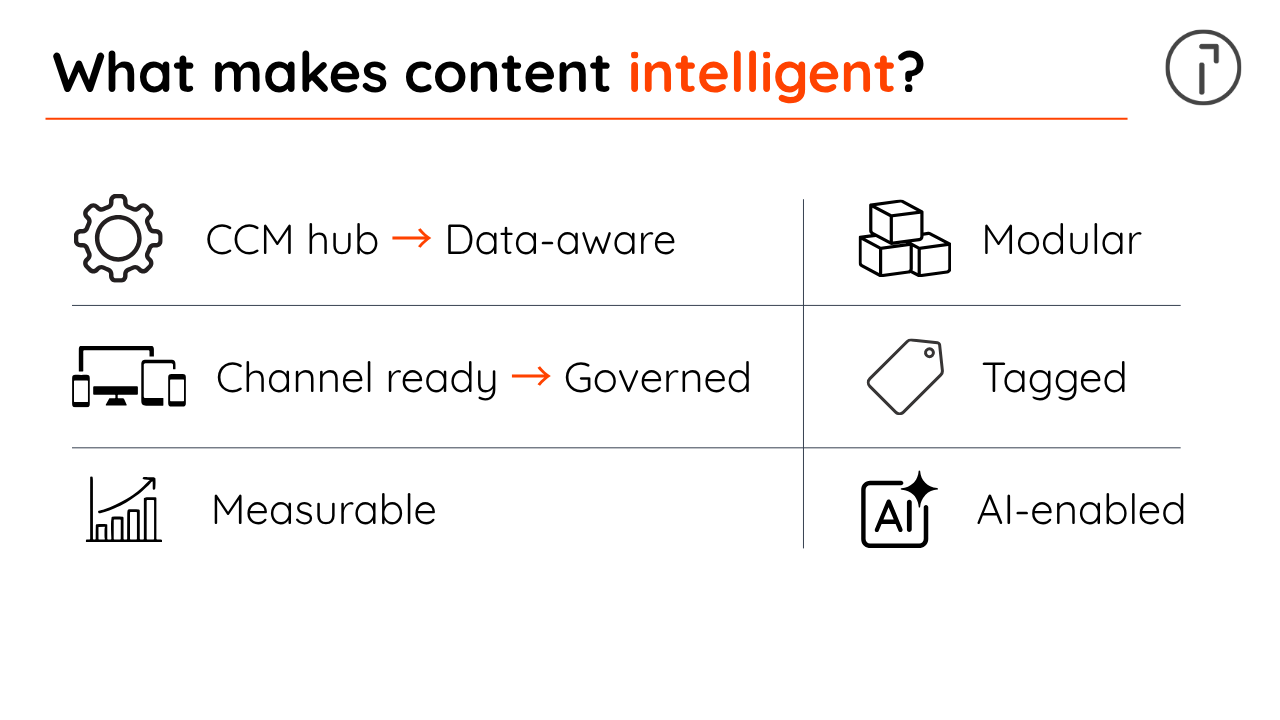
The role of CCM
Customer communication management serves as the hub for intelligent content creation and delivery. It connects your content model to systems of record such as CRM, billing, and support, then orchestrates delivery to each channel. It also integrates with cloud enterprise content management, allowing approved assets and blocks to move smoothly across the stack. The result is one source of truth for templates, fragments, media, rules, and policies. Teams work from the same library, which removes duplication and speeds time to market.
CCM supports batch, on-demand, and interactive communications, enabling teams to produce statements at scale, trigger event-based messages, and guide live conversations from a single source of truth.
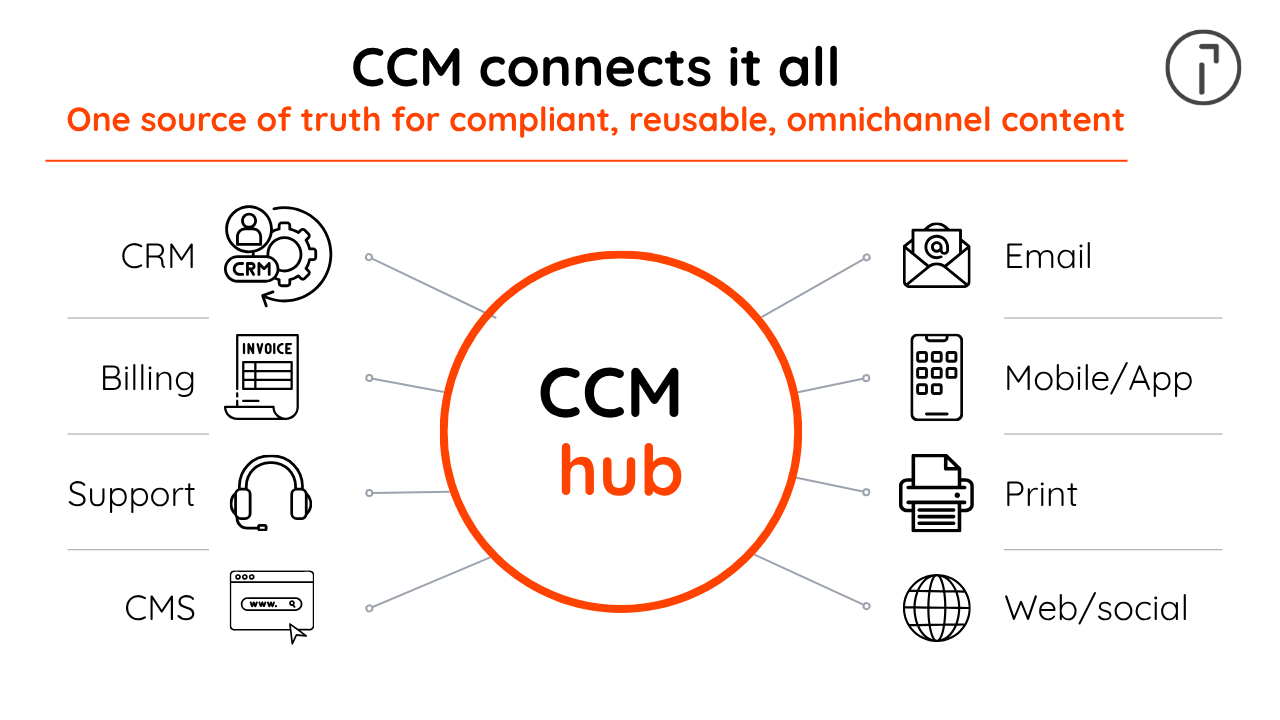
Building the foundation
A strong base keeps teams fast and compliant. Put these elements in place so your content model, data, and workflows work together from day one.
- Strategy: Use customer journey mapping to identify segments and use cases. Prioritize high-volume or high-friction communications such as onboarding, billing, renewals, and service notices.
- Content model: Define reusable elements and their relationships. Standardize your approach to handling regional variants, legal text, and accessibility.
- Metadata and rules: Create a schema for tags and decision logic. Use semantic AI to make content discoverable and context-aware. Bring in unstructured data where it improves personalization.
- CCM as hub: Centralize templates and fragments. Integrate with CRM, data platforms, consent management, a digital asset management system, and a headless CMS to support omnichannel customer experience, multichannel publication, and reuse.
- Governance: Set roles, approval paths, retention rules, and audit controls. Publish clear content guidelines and train teams.
- Privacy and compliance: Align content and data use with regulations and internal policy. Include redaction, consent, and disclosure patterns.
How intelligent content transforms the journey
Intelligent content improves every stage of the journey. Here is how it guides people from first touch to ongoing support.
- Discovery to conversion: Predictive analytics and rules ensure the right offers and explanations reach the right people at the right time.
- Onboarding: Dynamic checklists, welcome emails, and in-app guides adjust to the customer’s product and profile.
- Self‑service and support: Virtual assistants and AI contact centers deliver consistent answers that match the knowledge base and policy.
- Omnichannel consistency: CCM keeps wording and legal language aligned across web, app, email, print, and social media.
- Proactive engagement. Feedback, usage signals, and social listening surface issues early so you can respond before they escalate.
Putting intelligent content into action
Follow the steps below to transition smoothly from audit to rollout without introducing additional complexity.
- Audit: Inventory top communications, volumes, defects, and cycle times. Identify duplicate content and policy drift.
- Model: Break priority communications into reusable blocks. Define the metadata and rules each block needs.
- Compose: Build templates that assemble blocks based on audience, channel, and jurisdiction.
- Connect: Integrate data sources, consent, and identity. Set guardrails for how data can drive content.
- Automate: Use workflow automation for authoring, legal, compliance, localization, and publishing.
- Test and learn: Run A/B tests on subject lines, layouts, and offers. Measure impact by segment and channel.
- Roll out: Start with one journey, then scale to adjacent journeys using the same library.
- Continuously improve: Use performance data and feedback to retire weak content and promote high performers.
Tip: Stand up a small content operations team that includes a content strategist, a content librarian, a legal reviewer, a data specialist, and a channel owner. Give them a shared backlog and clear service levels.
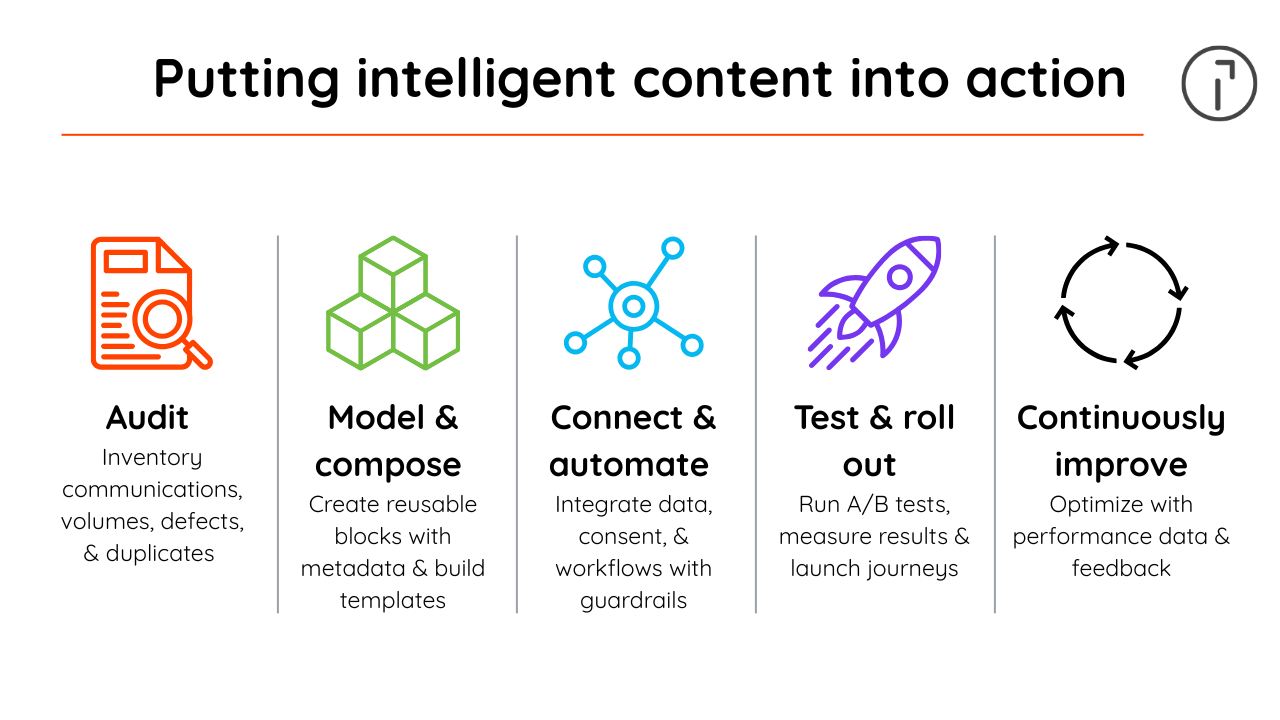
Measuring success
Track progress with a mix of experience and operational metrics. Start with customer outcomes, then measure how well your content operation runs.
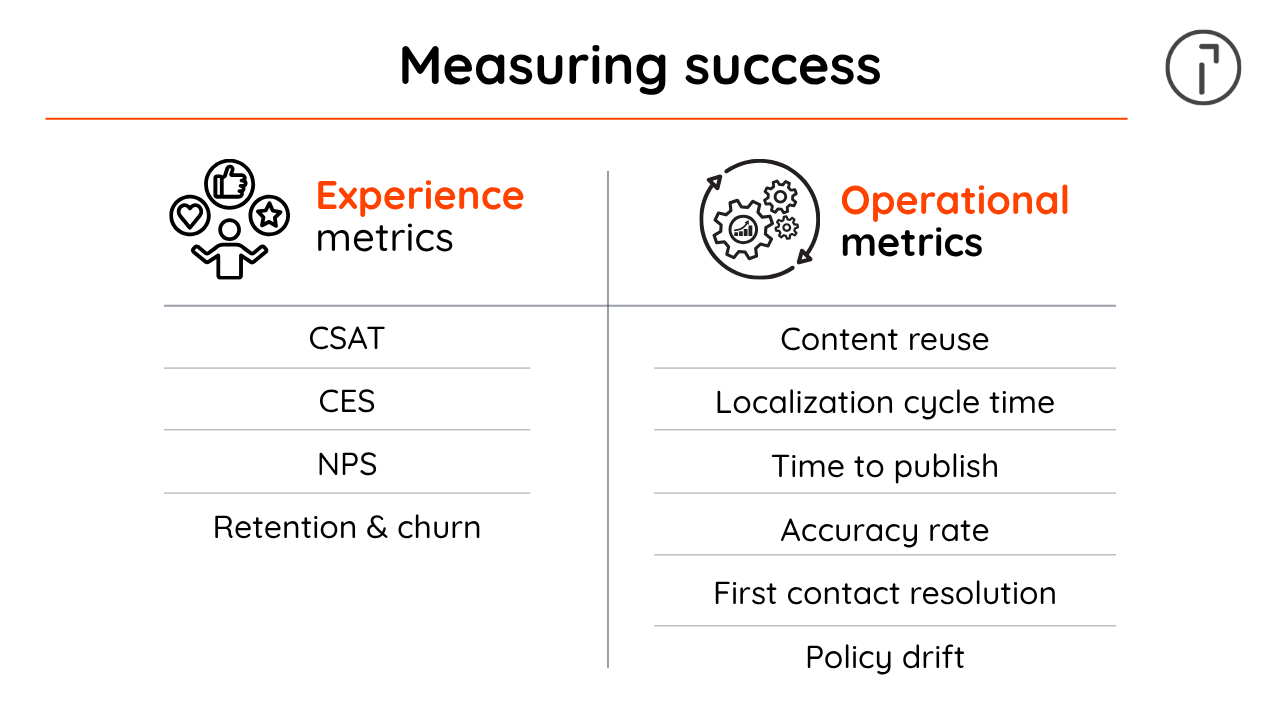
Experience metrics
These metrics indicate whether customers perceive your messages as clear and helpful during key moments.
- CSAT: Percent of positive survey responses after key interactions.
- CES: Customer effort to complete a task or resolve an issue.
- NPS: Likelihood to recommend, measured by promoters minus detractors.
- Retention and churn: Renewal rate and voluntary churn by segment.
Operational metrics
Make content reuse rate and localization cycle time your primary CCM indicators, then track the supporting metrics below.
These measures show if your teams create, approve, and publish content quickly and accurately.
- Content reuse rate: Percent of new communications built from approved blocks.
- Localization cycle time: Days to release a translated or regionalized version.
- Time to publish: Days from brief to live. Track baseline and improvement.
- Accuracy rate: Content released without defects or retractions.
- First contact resolution: Percent of issues solved in the first touch.
- Policy drift: Number of variants that stray from approved wording.
Utilize a dashboard in your CCM platform to enable leaders to view progress on reuse and localization time alongside CSAT, CES, and NPS.
Common pitfalls and how to avoid them
Teams often encounter the same issues when scaling. Watch for these risks and use the fixes noted here.
- Too many templates: Focus on reusable blocks, not one-off templates.
- Weak metadata: Invest early in a clear tagging schema. Poor tags limit discoverability.
- Automation without governance: Define approvals and audit trails before you scale.
- Personalization creep: Only use data that customers expect and have consented to.
- Neglecting accessibility: Follow WCAG guidelines for wording, contrast, and structure.
A 90‑day roadmap
Here is a simple plan you can execute in three phases. Each phase builds upon the last, allowing you to deliver value early and maintain momentum.
- Days 1 to 30: Audit content, define KPIs, select the first journey, and draft the content model and metadata.
- Days 31 to 60: Configure CCM, integrate core data, and build reusable blocks and templates. Stand up workflow and approvals.
- Days 61 to 90: Launch pilot communications, test variants, and publish a dashboard. Document wins and plan the next journey.
Looking ahead
Generative AI, augmented reality, and semantic search will make content more adaptive and predictive. CCM will continue to serve as the orchestration layer that connects these tools, enabling you to scale personalization and remain compliant.
Conclusion
Intelligent content is now at the heart of the customer experience. Structure it, add metadata, and manage it with CCM to deliver timely, relevant, and measurable messages that move teams from a reactive to a proactive approach. Ready to see it in action for your organisation? Request a Quadient demo.





